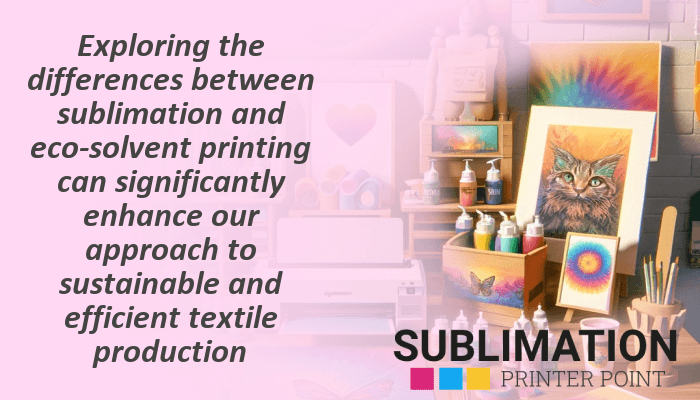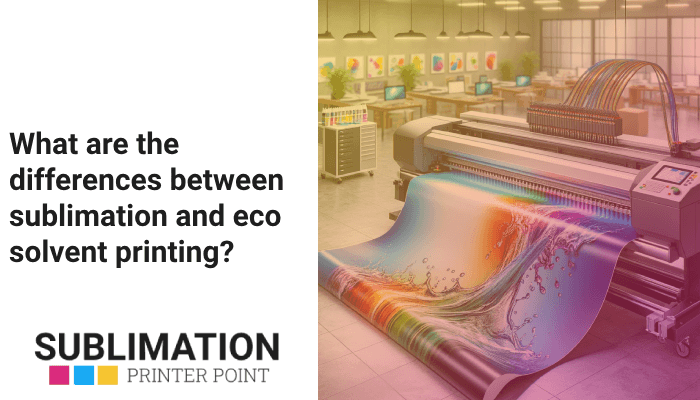Outdoor advertising and fabric printing are changing as a result of printing technologies, especially sublimation and eco solvent printing. Find more about the cutting-edge procedures and uses that set these techniques apart in the market.
Sublimation printing uses heat to convert solid ink into gas that permeates fabric and solidifies into its fibers, producing vibrant, high-resolution images. This method works especially well for printing on synthetic materials. However, eco solvent printing, which uses ecologically friendly solvent inks to produce superb, weather-resistant prints, is ideal for outdoor advertising materials. Both methods are widely utilized in digital printing and the textile industry because they offer outstanding color fastness and print durability.
- Sublimation printing employs heat to convert solid ink into gas, creating vibrant, high-resolution images.
- Eco solvent printing uses eco-friendly inks, producing high-quality, weather-resistant prints suitable for outdoor use.
- Both techniques offer high print durability and color fastness, making them ideal for various applications.
- Sublimation printing is effective for synthetic materials, while eco solvent printing is used for a variety of materials, including outdoor advertising materials.
- These methods have significantly influenced the textile industry and digital printing, offering new possibilities for print media.
What is sublimation printing and how does it work?
The innovative method of sublimation printing uses heat to immediately convert solid sublimation ink into gas, omitting the liquid phase. The core of sublimation printing is this phenomena, called phase change. Once the ink is in gaseous form, it seeps into the cloth and becomes embedded in the fibers. The end product is a sharp, high-resolution picture that won’t fade or wear out. This technique is well-liked for producing personalized clothing, signs, and promotional products since it works especially well when printing on polyester or other synthetic textiles.
What is the role of heat transfer in sublimation printing?
Sublimation printing relies heavily on heat transfer. The phase transition of the sublimation ink is triggered by the heat press process, which includes applying high temperatures and pressures to the sublimation paper. Through this method, the ink is able to penetrate the cloth and solidify into the fibers without first going through a liquid stage. To create vivid, long-lasting prints that won’t fade or peel over time, heat transfer is essential.
How does dye sublimation contribute to print quality?
The excellent print quality attained in sublimation printing is mostly due to dye sublimation. Dye sublimation permits the ink to penetrate the fabric, in contrast to conventional printing techniques that only stencil the ink onto the surface, producing a print that is vivid and durable. Dye sublimation produces images with more clarity and more brilliant colors, which makes it a great option for high-quality printing.
It may surprise you to learn that not all types of materials are suited for sublimation printing. Polyester and other synthetic materials perform best with it. Make sure your selected material is compatible if you’re thinking of using sublimation printing for a project in order to get the best results.
What is the significance of sublimation ink and sublimation paper in the process?
Two essential elements of the sublimation printing process are sublimation paper and ink. Because of its special formulation for this procedure, the ink may change from a solid to a gas when heated and compressed. In contrast, the purpose of the sublimation paper is to retain the ink until it is transferred onto the cloth. The final print’s color vibrancy and longevity are greatly influenced by the quality of these two elements.
What is eco solvent printing and how does it function?
Eco solvent printing is a technique that creates excellent prints using environmentally friendly solvent inks. Compared to conventional solvent inks, the ink made of ethyl alcohol is less detrimental to the environment and public health. Using a wide-format printer, the eco solvent ink is sprayed onto the material during the printing process. The material’s surface is subsequently penetrated by the ink, producing a strong, weather-resistant print. This technique is frequently applied to outdoor advertising products like car wraps and banners.
What is the importance of eco solvent ink in this printing technology?
The foundation of eco solvent printing technology is eco solvent ink. Because of its special composition, it can create prints of excellent quality that are impervious to fading and weather damage. Eco solvent ink is a more environmentally friendly and health-conscious option for printing than conventional solvent inks. Because of the ink’s resilience and color fastness, outdoor applications—where prints are subjected to inclement weather—benefit greatly from its use.
How does eco solvent printing contribute to outdoor advertising materials?
The process of creating materials for outdoor advertising has been transformed by eco solvent printing. Its ability to create strong, weather-resistant prints makes it the perfect option for car wraps, billboards, and outdoor banners. The colorful and noticeable advertising message is guaranteed to last for a considerable amount of time because to the superior prints made by eco solvent printing, which resist fading even in the most severe weather.
Eco solvent inks produce excellent, weather-resistant prints while also being kind to the environment. They are therefore a great option for materials used in outdoor advertising. But keep in mind that they need more time to dry than other inks.
What is the role of wide format printing in eco solvent printing?
Eco solvent printing relies heavily on wide format printing. It makes it possible to produce prints on a wide scale without sacrificing quality. Large, striking prints are crucial for drawing attention on outdoor advertising items, thus this feature is especially helpful. Wide format printers are perfect for outdoor applications because they can produce vivid, high-resolution prints that are resistant to fading and weather damage when they are fitted with eco solvent inks.
How does sublimation printing compare to eco solvent printing in terms of print durability and color fastness?
Both eco solvent printing and sublimation printing provide excellent print durability and color fastness. Because of its special heat transfer method, sublimation printing produces prints that are resistant to fading and wear by allowing the ink to penetrate the cloth. However, eco solvent printing creates prints that are strong and resistant to weather, which makes it perfect for outdoor applications. Nevertheless, the particular demands and specifications of the project will eventually determine which of the two approaches is best.
How does the heat press technique in sublimation printing affect print durability?
Print longevity is greatly increased in sublimation printing by using the heat press technique. The heat press method makes sure the print is resistant to fading and wear by changing the ink from a solid to a gas and letting it seep into the cloth. This method produces prints that are brilliant, high-quality, long-lasting, and resilient, which makes them perfect for uses where longevity is required.
What is the impact of eco solvent ink on color fastness in eco solvent printing?
In order to achieve color fastness in eco solvent printing, eco solvent ink is essential. Because of its special makeup, it may permeate the material’s surface and produce a print that won’t fade even in the most adverse circumstances. Because of this feature, eco solvent ink is a great option for outdoor applications where prints are frequently exposed to the sun and other elements of the environment that can fade them.
What are the applications of sublimation and eco solvent printing in the textile industry?
The textile industry has made widespread use of eco solvent printing and sublimation. Fabric printing is frequently done using sublimation printing, especially on synthetic fabrics like polyester. It’s perfect for making personalized clothing, marketing products, and signage. In contrast, eco solvent printing is a viable option for outdoor applications like car wraps and banners since it can create strong, weather-resistant prints on a range of materials.
How is sublimation printing used in fabric printing?
Because it can create prints with brilliant colors and excellent resolution, sublimation printing is frequently utilized in fabric printing. Sublimation ink is converted from a solid to a gas by the use of heat, which enables the ink to seep into the fabric and solidify into the fibers. This produces a print that is resistant to fading and wear, which makes it a great option for promotional products, personalized clothing, and other products made of fabric.
What are the uses of eco solvent printing in the textile industry?
The textile industry uses eco solvent printing to create prints that are resilient to weather. The environmentally friendly solvent ink reaches the surface of the material, producing a print that is impervious to fading and weather damage. Because of this, environmental solvent printing is the best option for outdoor uses like vehicle wraps and banners. It can also be used to print on a range of materials, such as canvas, vinyl, and specific kinds of cloth.
How do sublimation and eco solvent printing techniques influence digital printing and print media?
Print media and digital printing have been greatly impacted by sublimation and eco solvent printing techniques. Fabric printing has been completely transformed by sublimation printing thanks to its special heat transfer method, which produces prints that are vivid and of excellent quality. Conversely, eco solvent printing has increased the potential for outdoor advertising by enabling the production of strong, weather-resistant prints. By presenting fresh options for print material, both techniques have advanced digital printing.

What is the role of sublimation printing in digital printing?
Digital printing involves a lot of sublimation printing. Its distinct heat transfer method makes it possible to produce vivid, excellent prints on a range of surfaces. This technique is well-liked for producing personalized clothing, signs, and promotional products since it works especially well when printing on polyester or other synthetic textiles. Sublimation printing is an invaluable technique in the world of digital printing because of its quality and versatility.
How does eco solvent printing affect print media?
Print media are significantly impacted by eco solvent printing. It is the perfect option for outdoor advertising products because of its capacity to create strong, weather-resistant prints. The colorful and noticeable advertising message is guaranteed to last for a considerable amount of time because to the superior prints made by eco solvent printing, which resist fading even in the most severe weather. This has increased print media’s potential, especially in the area of outdoor advertising.

